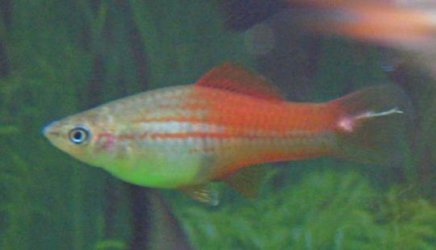It look like anchor worm to me as well as it looks like a forked tail at the end of the stringy thing.
Not the writer of this information below.
Anchor Worm (see photos) worms appear as 1/4 to 3/8 inch piece of string that has a forked tail. Anchor worms that grow large are easily detectable and cause considerable distress to the fish. In most cases, the parasite is introduced into the aquarium from live foods. Anchor worms will bore through the skin of the fish, creating ulcerations or blood spots on the fish's body. (Don't confuse this ulceration with those caused by bacterial diseases). You will want to treat for this immediately it is contagious! Symptoms: Clear to white, green or brown-red string-like worms, with forked tails are visible on the skin, head or mouth of the fish. Open sores may also appear on the fish's skin with the worms(parasites) protruding from the sore. Treatments: If you can see the parasites you can kill them with Dimilin. It is a gyrase inhibitor that is added directly into the water. It is non-toxic to the fish. It will clear the parasites within 3 to 4 days. Visit your local petstore and purchase some medication that states it treats anchor worms and follow directions accurately! Another method is to take a pair of tweezers and carefully remove the worm. (back to top)
Not the writer of this information.
Anchor Worm (a.k.a. Lernaea)
Symptoms:
Infected fish can be seen with whitish red worm-like threads, about ¼ inch long. Trailing at the rear of female parasites are two long, tube-like egg sacs. The parasites can be found anywhere on the body of the fish, including the eyes, gills and fins. Raised ulcers may appear at the site of attachment. Consequently, secondary bacterial infections may occur. The tale-tale sign that your fish is infected will be if you notice it rubbing or scraping against objects in the aquarium. It does this in an effort to remove the parasite.
Cause:
The parasitic crustacean Lernaea. Lernaea burrow into the muscle and gill tissue of fish, often times reaching as deeply as the internal organs, causing severe damage. Heavy infestations can cause significant weight loss and death.
Treatment:
You should kill all visible worms by dabbing them with a cotton swab, dipped in Potassium Permanganate or an anti-parasitic medication. Then you should carefully remove them from the fish with tweezers. You should kill the parasites before removing them because if they have burrowed deeply, removing them alive could cause the fish pain and significant physical damage. Once you’ve removed the parasite, you should then dab the wounds with Methylene Blue to prevent secondary bacterial infections from occurring. It is highly recommended that you feed the fish with medicated food. The tank will also need to be treated to kill any unseen, free-swimming juvenile parasites. You can use Fluke Tabs, Clout, Paragon or Trifon for this.

